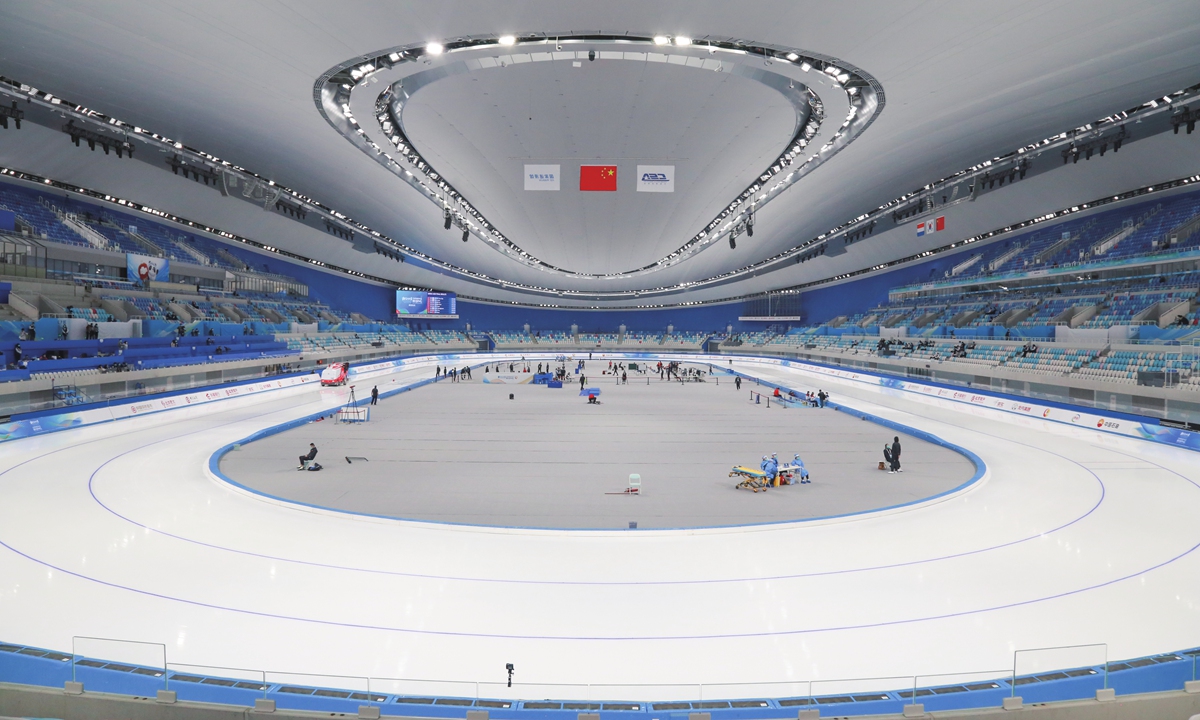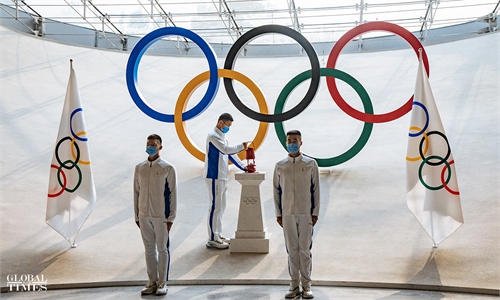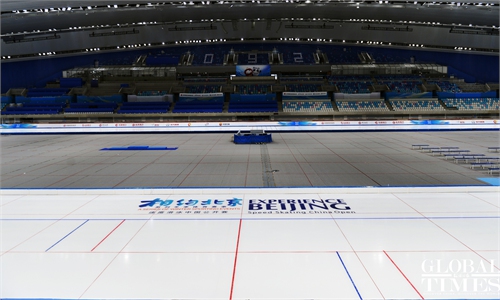Ice Ribbon, the only new Beijing Olympics arena, fully adopts green concept, designed for epidemic safety

China's National Speed Skating Oval, dubbed the "Ice Ribbon," has about 12,000 seats in a beautiful combination of blue and white. Photo: Zhao Juecheng/GT
With less than 100 days to go until the Beijing 2022 Olympic Winter Games, the Olympic atmosphere in the city is getting more intense. Beijing has finished the construction of competition arenas in the city, of which the National Speed Skating Oval, dubbed the "Ice Ribbon," with the concepts of energy conservation and epidemic prevention prevailing in its design, is the only arena that has been newly built for the Games.
Global Times reporters visited the arena, which will hold speed skating competitions during the Beijing 2022 Olympic Winter Games, where 14 gold medals will be awarded, gaining an in-depth understanding of the green concepts involved as well as the epidemic-proof design.
The National Speed Skating Oval is located close to the Bird's Nest and Water Cube, the iconic venues of the 2008 Beijing Olympics, forming an Olympic complex.
Its curtain wall is surrounded by 22 crystal ribbon-like curved glass walls, which is why it's been dubbed the "Ice Ribbon." The design was inspired by the ribbon-like traces of skaters on the ice during the speed skating competition, echoing the main function of the arena.
"The 'Ice Ribbon' was built on the site of the former hockey and archery arena for the 2008 Beijing Olympic Games," Huang Hui, director of the Urban Venue Construction Department of the Beijing Major Projects Office, said on Thursday.
"In the construction process, the original ecosystem of the site was fully preserved, and the original 8,000 square meters of grass and forest were also retained," Huang said.
Entering the venue, signs saying "Wear a mask" and "Keep a social distance" could be seen everywhere. On the huge and quiet ice rink, workers were making the final light adjustments, waiting for the world's best athletes to show in February.
The arena has about 12,000 seats in a beautiful combination of blue and white.
Zheng Fang, chief designer of the stadium, told the Global Times that the venue was designed from the start with special consideration for epidemic prevention.
"We deliberately designed the different movement lines for spectators, athletes and staff to ensure that spectators and event personnel will have different trajectories and will not come into contact with each other," Zheng said.
"The competition hall is part of the closed-loop bubble and there will be a strict epidemic prevention policy for entry and exit. There is also a special nucleic acid testing room and isolation room in the 'Ice Ribbon.""
Zheng noted that with the current sporadic epidemics of COVID-19 across China and the onset of winter, the personnel and venue designers are still working to improve the venue's epidemic prevention capacity.
Energy efficiency and environmental protection were the core concepts that prevailed in the construction of the Ice Ribbon.
Ma Jin, who is in charge of the design of the venue's ice-making system, said on Thursday that the entire process of ice-making applies carbon dioxide, taking into account green and energy-saving requirements.
The Ice Ribbon also has intelligent sports management, spectator management and venue management systems.
For example, through intelligent management, the temperatures in different parts of the pavilion can be stratified. The temperature near the ice surface, where the players will be competing, will be adjusted at around 10 C to facilitate the players to do their best. At the same time, the temperature in the spectator area can reach 16 C, making it more comfortable to watch the Games.
The Ice Ribbon adopts the public-private partnership operation mode, in which the government provides 28.9 percent of the financial resources to leverage social capital and technology in the construction of the venue.
After the Winter Olympics, the arena will be open to the public, Huang said. "The facilities will be part of the Olympic legacy, providing services for ice sports.
As Beijing builds venues and supporting facilities that can be used for the long term, residents are showing their warm support for the upcoming Winter Olympics. According to official figures, more than 1 million people applied to volunteer for the Beijing Winter Olympics to provide free services, even if it means a long period of quarantine beforehand.
The 2022 Beijing Winter Olympics will be held from February 4 to February 20, 2022 in Beijing, its Yanqing district, and the neighboring Zhangjiakou in Hebei Province.


